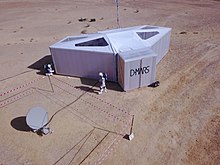| This article needs to be updated. Please help update this article to reflect recent events or newly available information. (August 2021) |
You can help expand this article with text translated from the corresponding article in Hebrew. (August 2021) Click for important translation instructions.
|


D-MARS is a human analog mission to the planet Mars, taking place in Makhtesh Ramon in the Negev desert in Israel. D-MARS is an acronym for "Desert Mars Analog Ramon Station" and its crew are known as "ramonauts". Ramon's geological features and aridity are similar to those of Mars. The mission site is a valley that resembles the impact craters of Mars.
Several missions have been carried out since the beginning of 2018, each staffed by six crew. They have performed experiments across many disciplines, including physics, soil studies, microbial studies, psychology, agriculture, water supply and engineering. Their suits were designed by the Israeli fashion designer Alon Livne.
The first mission took place for 4 days in February 2018. In 2019 the mission lasted for 11 days and in 2020 two student missions were held in March and 5 day training were held in November. In 2021 the mission took place from 4 to 31 October and six astronauts from Austria, Germany, Israel, the Netherlands, Portugal and Spain took part in the mission with mutual cooperation of Austrian Space Forum and Israel Space Agency.
See also
References
- ^ Simona Shemer (30 January 2018). "Israelis On 'Mars': Astronauts To Simulate Life On Red Planet In Desert Habitat". No Camels.
- "About D-MARS". Archived from the original on 2019-04-15. Retrieved 2019-04-15.
- Yonatan Sredni (10 January 2017). "Mission To Mars: Israeli Scientist Prepares To 'Live' On Mars". No Camels.
- D-MARS analog on Twitter - Brownlee, Scott (2021-10-23). "Astronauts settle into their Martian base camp on Earth". euronews. Retrieved 2022-07-15.
- "AMADEE-20 Mars Simulation". Austrian Space Forum (OeWF). Retrieved 2022-07-15.
This space- or spaceflight-related article is a stub. You can help Misplaced Pages by expanding it. |
Categories: